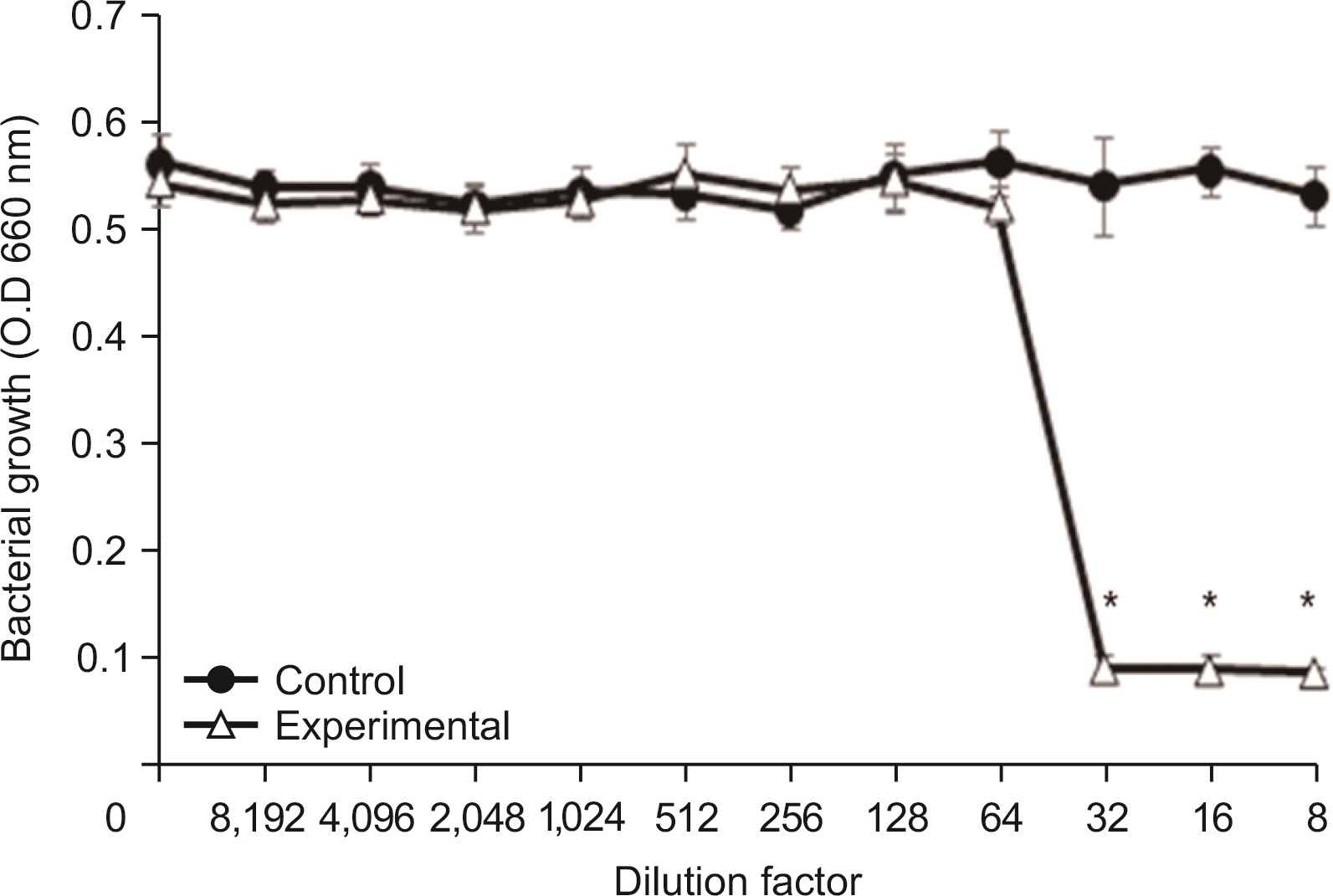J Korean Acad Oral Health.
2022 Dec;46(4):174-178. 10.11149/jkaoh.2022.46.4.174.
Antimicrobial effects of green tea extract-containing dentifrice
- Affiliations
-
- 1Department of Oral Health, College of Health Science, Dankook University, Cheonan, Korea
- 2Department of Preventive Dentistry, College of Dentistry, Dankook University, Cheonan, Korea
- KMID: 2537811
- DOI: http://doi.org/10.11149/jkaoh.2022.46.4.174
Abstract
Objectives
This study aimed to evaluate the antibacterial activity of green tea extract containing dentifrice on oral disease-causing bacteria.
Methods
The antibacterial activity of green tea extract containing dentifrice was examined on the gram-positive bacteria Actinomyces israelii, Enterococcus faecalis, Filifactor alocis, Streptococcus mutans, and gram-negative bacteria Fusobacterium nucleatum, Porphyromonas gingivalis. A. israelii, E. faecalis, F. alocis, S. mutans, F. nucleatum, and P. gingivalis were cultured with green tea extract containing dentifrice or control dentifrice; they were then incubated at 37°C under anaerobic conditions and cultured. Following incubation, a microplate reader was used to measure the absorbance and observe the number of bacteria. Statistical significance tests were conducted using the Mann-Whitney test and SPSS 24.0.
Results
Green tea containing dentifrice has antibacterial activity against A. israelii, E. faecalis, F.alocis, S. mutans, F. nucleatum, and P. gingivalis. Furthermore, green tea containing dentifrice killed more than 99.99% of 4 strains of gram-positive bacteria and 2 strains of gram-negative bacteria.
Conclusions
The detergent with green tea extract is significantly reduced the bacteria applied in this experiment; dentifrice has a bactericidal and antibacterial effect against oral bacteria. Therefore, the detergent with green tea extract is thought to be helpful in preventing dental caries and periodontal disease.
Figure
Reference
-
References
1. Hamada S, Koga T, Ooshima T. 1984; Virulence factors of Streptococcus mutans and dental caries prevention. J Dent Res. 63:407–411. DOI: 10.1177/00220345840630031001. PMID: 6230378.2. Loesche WJ. 1986; Role of Streptococcus mutans in human dental decay. Microbiol Rev. 50:353–380. DOI: 10.1128/mr.50.4.353-380.1986. PMID: 3540569. PMCID: PMC373078.3. Kim TI, Choi EJ, Chung CP, Han SB Ku Y. 2002; Antimicorbial effect of Zea Mays L. and Magnoliae cortex extract mixtures on periodontal pathogen and effect on human gingival fibroblast cellular activity. J Korean Acad Periodontol. 32:249–255. DOI: 10.5051/jkape.2002.32.1.249.4. Socransky SS. 1970; Relationship of bacteria to the etiology of periodontal disease. J Dent Res. 49:203–222. DOI: 10.1177/00220345700490020401. PMID: 4313844.5. Darveau RP, Tanner A, Page RC. 1997; The microbial challenge in periodontitis. Periodentol 2000. 14:12–32. DOI: 10.1111/j.1600-0757.1997.tb00190.x. PMID: 9567964.6. Park IS. 2010; Lee SH. A study on the amount of toothpaste used among some college students. J of Korean soc of Dent Hyg. 10:577–584.7. Gjermo P, Rolla G. 1971; The plaque inhibition effect of chlorhexidine containing dentifrice. Scan J Dent Res. 79:126–132. DOI: 10.1111/j.1600-0722.1971.tb02002.x. PMID: 5280247.8. Ciancio SG. 1992; Agents for the management of plaque and gingivitis. J Dent Res. 71:1450–1454. DOI: 10.1177/00220345920710071701. PMID: 1629462.9. Kim BI, Kim SN, Chang SY, et al. 2005; A highly selective antibacterial effect of Curcuma xanthorrhiza extract against oral pathogens and clinical effectiveness of a dentifrice containing Curcuma xanthorrhiza extract for controlling bad breath. J Korean Acad Dent Health. 29:222–237.10. Kim TI, Yeom HR, Ryu IC, Bae KH, Chung CP. 1996; Clinical and microbiological study on the effect of Magnoliae cortex and Ginkgo biloba extracts containing dentifrice in gingivitis. J Periodontal Implant Sci. 26:542–556.11. Cho MJ, Hong SJ, Choi CH, Jeong SS. 2005; Effects of dentifrice containing extract of Galla Rhois or Psoralea corylifolia on inhibition of plaque formation. J Korean Acad Dent Health. 29:141–152.12. Seo HW, Park HW, Kim JS, Lee SY, Shin IS. 2012; A control of plaque, gingivitis and anti-caries effect of dentifrice containing horseradish extracts. J Korean Acad Pediatr Dent. 39:26–33. DOI: 10.5933/JKAPD.2012.39.1.26.13. Chung HY, Yokozawa T. 1995; Studies on antiaging and antimutagenic mechanism of epigallocatechin 3-O-gallate isolated from green tea. Food Sci Ind. 28:46–58.14. Sung KC. 2006; A study on the pharmacetical characteristics and analysis of green-tea extract. J of the Korean Applied Sci and Tech. 23:115–124.15. Adria FA, Zidan OA. 2004; Natural products for dental caries prevention. J Med Food. 7:381–384. DOI: 10.1089/jmf.2004.7.381. PMID: 15383236.16. Kim SS, Won JH, Lee GE, Lee RR, Lee SM, Lee JH, Kang KH. 2017; Anti-bacteria effect of green tea, mulberry, and mate leaves extracts on S. mutans. J of Digital Convergence. 15:347–353. DOI: 10.14400/JDC.2017.15.1.347.17. Jorgensen JH. 1993; Antimicrobial susceptibility testing of bacteria that grow aerobically. Infect Dis Clin North Am. 7:393–409. DOI: 10.1016/S0891-5520(20)30528-6. PMID: 8345175.18. Choi MJ, Park JY, Lim MY, et al. 2017; Factors affecting usage of toothpaste in infants and preschoolers. J Korean Soc Dent Hyg. 17:49–62. DOI: 10.13065/jksdh.2017.17.01.49.19. Hattori M, Kubumoto IT, Namba T. 1990; Effect of tea polyphenols on glucan synthesis by glucosyltransferase from Streptococcus mutans. Chem Pharm Bull Tokyo. 38:717–720. DOI: 10.1248/cpb.38.717. PMID: 2140716.20. Maruyama T, Tomofuji T, Endo Y, et al. 2011; Supplementation of green tea catechins in dentifrices suppresses gingival oxidative stress and periodontal inflammation. Arch Oral Biol. 56:48–53. DOI: 10.1016/j.archoralbio.2010.08.015. PMID: 20869695.21. Lee ES, An TY, Yun JJ, Gug JG, Lee BL, Kim DG. 2003; Restraint effect on leaf-extract from Camellia sinensis and seed-extract from Casia tora against periodontopathogens. J Korean Acad Dent Health. 27:569–79.22. Min DJ, Yi SW, Lee SH, et al. 2011; The Anti-inflammatory effect of green tea extract against Prevotella intermedia. J Soc Cosmet Scientists Korea. 37:67–73.
- Full Text Links
- Actions
-
Cited
- CITED
-
- Close
- Share
- Similar articles
-
- Effects of Green Tea on Weight Gain, Plasma and Liver Lipids and Lipid Peroxidation in Pair Fed Rats
- Transactivation of peroxisome proliferator-activated receptor alpha by green tea extracts
- Effect of Natural Extracts on Oral Care Probiotics Weissella cibaria CMU and Periodontal Pathogens
- A comparison of anti-inflammatory activities of green tea and grapefruit seed extract with those of microencapsulated extracts
- Association Between Green Tea Consumption and Lung Cancer Risk







